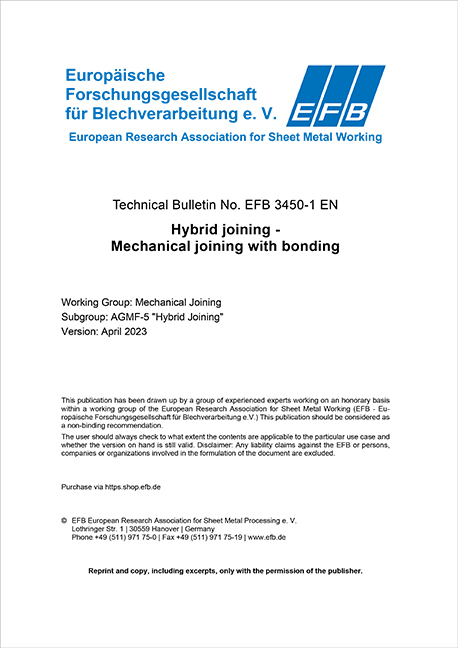Hybrid joining - Mechanical joining with bonding
Medien-Nr.:
MB-3450-1_EN
Produktnummer:
MB_3450-1-EN
Herausgeber:
Working Group: Mechanical Joining, Subgroup: AGMF-5 "Hybrid Joining"
Erscheinungsjahr:
1. April 2023
Seitenanzahl:
34
The purpose of this technical bulletin is to provide engineers and technicians working in design and production with generally applicable information on the use of hybrid joining (mechanical joining with bonding) in their industrial practice and to assist them in the layout of hybrid joints. The general objectives for hybrid joints are:
Contents
Keywords
1 Purpose and Scope of the Technical Bulletin
2 Basics
2.1 Terms and Definitions
2.2 Process Variants
2.3 Connection Properties
2.3.1 Quasistatic Stress
2.3.2 Vibratory Stress
2.3.3 Impact Stress
2.3.4 Ageing and Corrosion Behavior
2.3.5 Temperature Dependence of the Connection Properties
3 Design
4 Manufacturing
5 Quality Assurance
6 Repair and Rework
7 Occupational Safety and Environmental Protection
8 Procedure-specific Features
8.1 Self-pierce Riveting with Semi-tubular Rivets with Bonding
8.2 Self-pierce Solid-riveting with Bonding
8.3 Boltsetting with Bonding
8.4 Clinching with Bonding
8.5 Blind Riveting with Bonding
8.6 Lock Bolting with Bonding
8.7 Flow Drill Screw Driving
9 Literature
9.1 Standards and Technical Bulletins
9.2 Further Reading
10 Literature Used
- Improvement of the mechanical properties, the durability and the service life of joints
- Enhancement of the functional properties in comparison with elementary mechanical and adhesive joints (e.g. seam sealing, seam isolation, damping, prevention of contact corrosion)
- Optimization of the manufacturing process for an elementary joining process (e.g. joining part fixation)
The scope includes the combination of the mechanical joining methods, described in the various EFB technical bulletins, with the addition of bonding (see also DVS Guideline 3310 and DVS Guideline 3320) with regard to the joining of uncoated and coated steel, aluminum, magnesium as well as composite materials and plastics in the form of joined parts made of sheets, plates, profiles and castings in overlap arrangement.
Contents
Keywords
1 Purpose and Scope of the Technical Bulletin
2 Basics
2.1 Terms and Definitions
2.2 Process Variants
2.3 Connection Properties
2.3.1 Quasistatic Stress
2.3.2 Vibratory Stress
2.3.3 Impact Stress
2.3.4 Ageing and Corrosion Behavior
2.3.5 Temperature Dependence of the Connection Properties
3 Design
4 Manufacturing
5 Quality Assurance
6 Repair and Rework
7 Occupational Safety and Environmental Protection
8 Procedure-specific Features
8.1 Self-pierce Riveting with Semi-tubular Rivets with Bonding
8.2 Self-pierce Solid-riveting with Bonding
8.3 Boltsetting with Bonding
8.4 Clinching with Bonding
8.5 Blind Riveting with Bonding
8.6 Lock Bolting with Bonding
8.7 Flow Drill Screw Driving
9 Literature
9.1 Standards and Technical Bulletins
9.2 Further Reading
10 Literature Used

